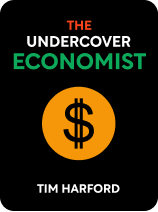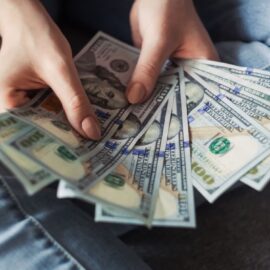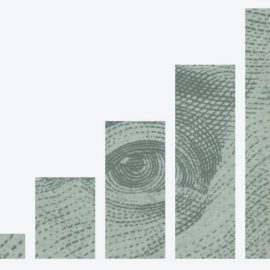

This article is an excerpt from the Shortform book guide to "The Undercover Economist" by Tim Harford. Shortform has the world's best summaries and analyses of books you should be reading.
Like this article? Sign up for a free trial here .
What can you learn from reading The Undercover Economist? What are the main takeaways from the book?
The Undercover Economist by Tim Harford will help you think like an economist without boring you with endless graphs or complex math. You’ll learn why you make the economic decisions that you do and what happens when the basic economic principles that efficiently govern much of the world break down.
Below is a brief overview of Tim Harford’s The Undercover Economist.
The Undercover Economist
In The Undercover Economist by Tim Harford, you’ll learn how to think like an economist and how to make better decisions every day using the following economic principles:
- Scarcity
- Price Targeting
- Externalities
- Missing Information
- The Stock Market
- Game Theory
- Globalization
Scarcity
The first important economic principle that we’ll examine is scarcity: the idea that strength in negotiation comes from having a scarce resource that others want. Let’s say a wheat farmer is looking for land, and there are a lot of landlords who have land available. In this case, the landlords will attempt to undercut one another to get the wheat farmer’s business, making the land cheap. However, seeing the success of one wheat farmer, more people want to farm wheat in the town, and the scarcity shifts. Now, it’s the land, rather than the farmer, that is the scarce resource. Landlords get increasingly more power and can start to charge higher prices.
The balance of power between the farmers and the landlords can shift quickly. If farmers decide that the landlords’ prices are too high for them to make money on the most fertile land in town (the meadowland), there won’t be any incentive for them to rent from the landlords. They’ll be more likely to rent from the landlords of less fertile land like grassland. These farmers may produce less wheat, but their costs will be lower, making up for the decrease in revenue. The shifts in the scarce resource between farmers and landlords have the potential to go on forever. Once farmers take up all of the meadowland and grassland, and a new aspiring farmer arrives, he’ll rent from the landlords of even less-fertile land like scrubland.
The scrubland, or the lowest-yielding land, will always necessarily be the least profitable. This example illustrates why. Let’s say the new farmers are making $10,000/year on the scrubland, and the old farmers are making $15,000/year on the grassland. If neither farmer is paying anything in rent, the grassland is more profitable. But if the grassland landlords are charging $7,500/year in rent, the old farmers would only take home $7,500/year in profits. If the scrubland was free to farm, the old farmers would all move to the scrubland, because they could take home $10,000/year. Thus, the grassland landlords charge only $5,000/year or less to keep their farmers, because the farmers are only willing to stay if they can make at least as much as they would have made farming scrubland ($10,000/year in profit).
(Shortform note: To better understand how scarcity affects the price (and value) of a good or service, read our summary of Basic Economics.)
Price Targeting
While individuals and companies can look to profit from scarcity, they don’t have ultimate power over their consumers. No matter how scarce their resource, if a company sets its price too high, the customer won’t buy what they’re selling. What they can do, though, is employ the strategy of price targeting, or setting different price points for different customers.
A typical Starbucks menu illustrates how companies can set unique price points: They have regular coffees, cappuccinos, or hot chocolates priced at a fairly low rate—let’s say $2. But if you want a larger size, or a special bean, or even a blend of two different types of coffee, you pay more—maybe $3. Customers know it doesn’t cost Starbucks an extra dollar to manufacture these “fancier” items, but some customers are still willing to buy them. The customer who just wants her coffee and is money-conscious might go for the $2 coffee. But the customer who cares less about what her coffee costs and is curious about a particular blend will go with the more expensive option. Businesses are constantly looking for the latter customer or the one who doesn’t care as much about the price.
One way for companies to find customers that care less about the price is to rent storefronts in prime locations. For example, storefronts for coffee shops in train stations are desirable. Customers getting a coffee on the way to catch a train are likely to be less discerning about the price, given that they have a train to catch and don’t have time to leave the station and look for a lower-priced option.
However, even storefronts in prime locations need to practice price targeting. If the coffee shops in train stations sell their coffee at too high a markup, even though they’re the only coffee shop in the area, people will just forgo their coffee. But if they sell coffee at too low of a price, they won’t make enough money to turn a good profit, because their rent is so high due to the desirable location. This is why setting different price points, so that people who are willing to pay more will, and people who aren’t won’t (but will still buy something), works so well.
Finding Efficient Markets
There’s nothing forcing stores to sell their product for a particular price, nor is there anything forcing customers to buy at a particular price. In the free market, though, products are generally almost equal to the marginal cost, or how much it costs to keep a business afloat, plus modest profits that convince investors it’s a little better to keep their money in the business than in savings.
Imagine, for a second, that everyone in the world has to tell the truth. You go to a coffee shop, and the barista asks you what you’d be willing to pay for the coffee. Being a caffeine addict, you reply, “$15.” But then, as the barista starts making the coffee, you ask, “How much did the beans cost? What about the machines, your salary, and everything else that it takes to run this place?” You find out that the total cost to make the coffee is less than a dollar. You keep going: “Are there any other places that sell similar coffee near here?” you ask. The barista responds that there are and that they sell coffee for a much lower price. You tell the barista that you’ll only buy the coffee at that lower price. You’ve managed to haggle what would have been a $15 coffee down to less than a dollar.
In a free market, when a seller sets an asking price, it’s equal to or higher than the cost to produce it. And when a buyer buys the product, the product is as valuable or more valuable to the buyer than the money changing hands. As the above example illustrates, lots of buyers value coffee more than they currently pay for it—you would have paid $15 for that coffee if necessary! Because the coffee market is competitive, though, firms are constantly trying to undercut one another to get your business. As such, the price of coffee is basically equal to the marginal cost.
This means that when it gets more expensive to make coffee, the price goes up. Anything from an employment shortage to a longer than expected cold season in Brazil can make coffee more expensive. All of this exists within an incredibly complex global economy. We could choose to spend the money that we spend on coffee on anything else. If fewer people wanted coffee daily, there would be fewer coffee shops, and something else would go in that real estate.
Externalities
The last section demonstrated how perfect markets work in theory. Even though we rarely find perfect markets in the real world, it’s useful to understand the idea of perfect markets because economists usually start there when they see imperfections. Economists attempt to remove these imperfections. In this section, we’ll discuss the effects of these imperfections in the marketplace, or externalities, and discuss when governments should step in to prevent negative externalities.
In the most basic form of the free market, everyone goes about their lives, selling and buying goods, without any regard for how their actions affect others. Often, though, the actions of one buyer or seller can affect a third party, who’s not involved in the sale of goods or services. This is called an externality. To prevent negative externalities, governments may impose externality charges.
Externality charges are the best way to disincentivize an activity that harms others because people will act in self-interest. When the government levies externality charges on activities that are selfish and harm others, it’s usually not in your best interest to continue to pursue the harmful activity. Thus, fewer people pursue harmful activities and there are fewer negative externalities.
Let’s use the example of drivers to expand on externalities and externality charges. Drivers get a lot of benefit from having a car because cars can allow them to get places quickly. But they also end up paying taxes on having a car. Gas taxes, for example, are high all around the world, and in a lot of places, drivers pay a tax for the privilege of having a car in the form of a license fee.
Here, we can see a distinction between average cost and marginal cost. On average, drivers end up paying a lot of money to keep a car. However, one 20-minute drive to a city center has a low marginal cost—the trip doesn’t cost them any more in license fees and probably won’t use much gas. On the other hand, trips into the city make city life worse for everyone without a car, thanks to noise pollution and carbon monoxide pollution. Cities can solve this problem by, instead of having one flat license fee, charging a tax for every time a driver takes a trip in a city.
In other words, lots of people are benefiting from driving themselves. But by benefiting themselves, they’re also harming others. This complicates the idea that everything we do in the market helps create a perfectly efficient system. (If it were perfectly efficient, drivers would have to pay the people whose lives they are making more difficult.)
Charging money for these externalities is a balancing act. We want to keep letting people do things they like, so we don’t want taxes on externalities to be too high. But we also want to make sure that people aren’t destroying the lives of those around them by doing what they want. Essentially, when figuring out externality taxes, we should attempt to imitate perfectly efficient markets as much as possible. We want the total cost to everyone else to be exactly equal to the benefit for one person.
Levying externalities is also situation-dependent. Charging people to drive at busy times in the city is a redistributive tax in the United Kingdom, where poorer people don’t drive. But in the United States, where poor people drive a lot, they end up paying a significantly higher percentage of their income on gas than rich people do. However, even in this case, it’s better to levy taxes on each trip into the city than it is to have one up-front tax. This way, poorer people can reduce their tax burden by choosing not to drive in the city as much, rather than having to pay a big tax every year and then feeling as if they need to justify it by driving in the city a lot.
Ultimately, externality charges are bound to be controversial. They are not an exact science, and some will argue that they are not tough enough, while others will argue that they are too tough.
Missing Information
When one party doing a business deal has more information than the other party, the market is not running efficiently. This section explains the information gap and how to close it.
Used Car Salesmen
We’ll use the example of used cars to explain the economic problems inherent in an information gap. Let’s say half the cars on the used car lot are “peaches”—they run well—and the other half are “lemons”—there’s something wrong with them. The car salesman knows which are which, and the buyer does not. The peaches are worth an average of $6,000 to buyers. The buyer offers $3,000, which she thinks is a fair gamble for a car that could be a peach or could be a lemon.
- If the car is a lemon, the seller will jump at the chance to sell a car he knows is worth less than $3,000.
- If the car is a peach, the seller will refuse to sell a car he knows is worth more than $3,000.
Consequently, buyers offering $3,000 will only ever get lemons. If the buyer offers closer to $6,000 the salesman might give up a peach, but the buyer wouldn’t be willing to put up something like $5,500 for a 50% chance she’s getting a lemon.
In this extreme example, there is literally no market. Buyers who have even an ounce of common sense just won’t shop for a used car. Consequently, sellers won’t sell many used cars. Insider information helps no one. This only occurs when one group is ignorant and the other has knowledge. If both the buyer and the seller are ignorant, the market would resolve itself. The problem is the knowledge gap.
(Shortform note: Read our summary of Freakonomics to learn how unequal access to information affects you when you’re buying a house, and how the Internet is closing the information gap.)
Signaling Quality
So, how can we solve the knowledge gap? The first way is for vendors to signal quality, or to show customers that they are reliable. There are lots of ways for vendors to do this. In the car salesman example, trustworthy salespeople often have a showroom that’s a lot fancier than a used car lot on the side of a highway. These showrooms are fairly expensive and require long leases. If a salesperson has roots in the community thanks to their lease, they can’t just pick up and leave if they start selling lemons and word gets around that they are not to be trusted. If they can’t quickly leave and move on to a new group of suckers, they’re disincentivized to withhold important information from customers. Thus, customers trust salespeople with showrooms because the quality of the showroom signals that the seller can’t rip the buyer off.
This is also why old banks often found fancy buildings to conduct their business out of. If you’re giving your money over to an organization to hold, you want to make sure that it’s trustworthy. Signposts of trust like a stately building aren’t just nice frills: The expensive lease in the fancy building makes sure that vendors will be honest with customers.
There are many signals of quality that don’t involve real estate as well. For example, people like to poke fun at students getting their degree in a subject like philosophy. The popular argument is that philosophy doesn’t give students any marketable skills that will help them make money. But finishing a philosophy degree is another signal of quality. Philosophical arguments are dense. While reading and writing about them might not be directly related to whatever job a philosophy student has after graduation, it shows a level of commitment that employers pick up on. If someone is excited to study philosophy, they likely have a good work ethic.
Remember, though, that all of these examples involve trade-offs. It might not be worth the money to pursue a philosophy degree, even if it does make it marginally easier to secure a job because you can better signal quality.
Finding Quality
While vendors can signal quality if they choose, it is often up to customers to find quality.
Let’s use renting an apartment as an example. When landlords show off an apartment to potential tenants, they are signaling quality by allowing customers to test that everything works in the apartment or look around the place and the neighborhood. But potential tenants and landlords can both find quality in one another to close the information gap. There are all kinds of forums where tenants can share positive or negative experiences about landlords: Potential tenants can seek out this information online, or ask other tenants in the building directly about whether the landlord is responsive. Landlords, though, need information about tenants as well before they agree to rent out their place. They don’t want tenants who can’t pay their rent. So they find quality: They regularly ask for bank statements, proof of employment, and tax returns. When each party has enough information about the other, they can comfortably complete the transaction.
The Stock Market
The stock market is a sector of the economy that is shrouded in secrecy. Complex jargon scares potential investors who don’t have a background in economics or finance. This section will help to lift that curtain. It will explain how stock prices are valued and why companies hire economists to help them play the stock market.
It’s difficult to make more money than an average investor in the market. This is because, if you’re following the law (and not trading off of insider information), everyone is working with the same information. A report that says that stock prices will go up tomorrow, for example, will make stock prices go up today because people will buy them expecting them to go up tomorrow. When investors buy more of a company’s stock than other investors sell, the stock price goes up.
The market is a nearly random walk that trends upwards. Generally, as the world economy continues to grow, more people will put their money into the market. This leads to the upwards trend. It’s nearly random because people who are well informed about market conditions can, on aggregate, make a little bit more money than the average investor.
Future Value
Economists are hired by investment firms or individuals because they are generally right about the market’s direction a little bit more often than they are wrong. This is because they understand the future of markets a little bit better than the average person.
Stock prices are the representation of what the market thinks a company will earn in the future. Investors and economists are attempting to judge not the current profitability of a company, but what the current numbers and the state of the economy mean for a company’s future profitability.
When you buy a stock, you’re buying a small part of the company. Theoretically, as a shareholder, you get back part of a company’s profits. In practice, though, shares are more about prospects than profits. When a company makes a profit, it generally reinvests that money into growing its business. Companies spend money on the development of a new product or advertising of an existing one. As a shareholder in a company, you’re betting that they’ll have more success with their reinvestments and general growth than the market assumes.
The stock market, then, is less about companies’ fundamentals and more about what other people think of a company.
Game Theory
While economists can only be marginally helpful with the stock market, their successes and failures are much more on display when a government or a private company requires problem-solving with game theory.
Game theory is a discipline that is adjacent to economics and mathematics. We’ll define a “game” as an activity in which predicting another’s actions affects your own actions. Many everyday situations, like driving, are games. When you’re behind the wheel, you drive based on the rules of the road but also based on what behavior other cars on the road are exhibiting. If a car is driving erratically, or too quickly, you’ll likely switch into a more defensive driving mode. If a car in front of you is driving too slowly, you’ll attempt to pass.
Poker
Many game theorists have been fascinated with poker as an application for their theory. In poker games, you win an entire pot of money if you finish with the best hand. There are rounds of betting in which players make decisions based on how other players are behaving about whether to stay in a hand, in an attempt to win, or whether to get out of the hand and save their money. Players can calculate in real time whether it’s worth paying to stay in.
For example, in the poker game Texas Hold ‘Em, communal cards that everyone can see and use are shown by the dealer after every round of betting. Players are often looking for a specific card or kind of card to complete a hand. It doesn’t take too much math to figure out the probability of a card coming up and whether it’s worth it to pay to stay in the hand and look for your card.
Where it gets more complicated, and where game theory comes into play, is what the other players are doing. Players both figure out the probability of their best hand and predict whether their potential hands will beat their opponents’ potential hands. There are clues about what cards an opponent might have based on how they are betting, but they could be “bluffing,” or intentionally attempting to mislead other players into making a bad decision. Players also understand that the other players are analyzing their moves. This is why poker remains so popular and endlessly fascinating. It’s a game of secrets that’s governed by complex game theory and larger understandings of human behavior.
Globalization
Globalization can refer to many kinds of exchanges among nations, but we will define it as more trade between nations and more direct investment in other nations. Mostly, trade and direct investment take place between rich countries, though globalization is starting to influence poorer countries as well.
If you want to be rich, trade with the world. Take the example of Bruges and Antwerp in Belgium. For centuries, Bruges was a huge trading port. It connected Belgium to the rest of the world. In the 15th century, though, topographical changes made it impossible for ships to enter Bruges’s port. Trading moved to Antwerp, which maintains a huge economic advantage over Bruges to this day.
Increasingly, products made in one remote corner of the world are available for purchase in another.
Comparative Advantage
Much of the success of globalization is due to comparative advantage. Comparative advantage occurs when one group can make a product more efficiently than another group. We’ll use a simple example of building radios and televisions to illustrate this concept. Let’s say that in the United States, a factory worker can build a radio every 30 minutes and a television every hour. In China, a factory worker can produce a radio every 20 minutes and a television every 10 minutes. Without trade, it will take the worker 90 minutes to make a television and a radio in the U.S. and 30 minutes to make both in China. However, let’s say that the Chinese worker decides to make two televisions and the American worker makes two radios, and then they trade, swapping a TV for a radio and vice versa. Now, the Chinese worker has a radio and a TV in 20 minutes (as opposed to 30 minutes), and the American worker has a TV and a radio in an hour (as opposed to 90 minutes). Both win. If we disallow trading, we’re hurting everyone.
Certainly, the world economy is more complex than this example. We use currency and trade with multiple partners, which both obscure this simple principle. However, despite these added complexities, the general principle holds true.
Additionally, when nations put taxes on imports, they are unknowingly placing an equal tax on their exports. For example, if the U.S. puts a high tax on imports of Chinese TVs, effectively banning them, the American TV-making industry will benefit (people will buy the cheaper American TVs rather than the expensive Chinese ones). However, U.S. export industries will suffer: Say the U.S. exports radios in exchange for Chinese currency. Without Chinese imports to spend that currency on, the American industry’s revenue from China is essentially useless. Industries are thus competing with others in their own nation for comparative advantage.
Unfortunately, given the struggle for efficiency, some workers do lose their jobs in the globalized free market—it’s not good for everyone right away. These workers are forced to learn new skills and hope that more efficient producers that now have more demand from around the world will hire them. The government should help people who lose their jobs while continuing to pursue globalization.
(Shortform note: To learn more about the negative consequences of tariffs, read our summary of Economics in One Lesson.)
All of these economic principles—scarcity, price targeting, finding efficient markets, externalities, missing information, the stock market, game theory, and globalization—may have seemed impossibly complex before reading this summary. But The Undercover Economist proves that while economics can sound full of jargon, it is ultimately about people.

———End of Preview———
Like what you just read? Read the rest of the world's best book summary and analysis of Tim Harford's "The Undercover Economist" at Shortform .
Here's what you'll find in our full The Undercover Economist summary :
- How to think like an economist
- How to use principles like scarcity, price targeting, the stock market, and game theory to make better decisions every day
- Why the economy is mostly about people, not complex math, graphs, or jargon






